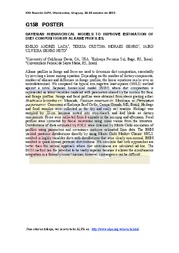Bayesian hierarchical models to improve estimation of diet composition by alkane profiles.
Bayesian hierarchical models to improve estimation of diet composition by alkane profiles.
Autoria: LACA, E. A.; GENRO, T. C. M.; GENRO NETO, J. S.
Resumo: Alkane profiles in forage and feces are used to determine diet composition, essentially by inverting a linear mixing equation. Depending on the number of dietary components, number of alkanes and difference in forage profiles, the linear equations can be over or underdetermined. We compared the typical non-negative least squares (NNLS) method against a novel Bayesian hierarchical model (BHM) where diet composition is represented as latent variables modeled with parameters shared by the models for fecal and forage profiles. Forage and fecal profiles were obtained from steers grazing either Brachiaria brizantha cv Marandu, Panicum maximum cv. Mombaça, or Pennisetum purpureum cv. Cameroon at Embrapa Beef Cattle, Campo Grande, MS, Brazil. Herbage and fecal samples were collected in the dry and early wet seasons. Herbage was sampled by 20-cm horizons sorted into stem/sheath and leaf blade as dietary components. Feces were collected from 6 animals in the morning and afternoon. Fecal profiles were corrected by faecal recoveries using mean values from the literature. Distributions of diets estimated by NNLS were obtained by Monte Carlo simulation of profiles using parameters and covariance matrices estimated from data. The BHM yielded posterior distributions directly by using Monte Carlo Markov Chains. NNLS resulted in highly variables diets with distributions that were clearly non-normal. BHM resulted in quasi-normal posterior distributions. We conclude that both approaches are better than the normal approach where diet covariances are calculated ad-hoc. The BHM method has the potential to be vastly superior because it allows the simultaneous integration in a formally correct manner, however, convergence can be difficult.
Ano de publicação: 2011
Tipo de publicação: Resumo em anais e proceedings
Unidade: Embrapa Pecuária Sul
Palavras-chave: Melhoramento forrageira, Modelo bayesiano, Perfil alcalino
Observações
1 - Por padrão são exibidas publicações dos últimos 20 anos. Para encontrar publicações mais antigas, configure o filtro ano de publicação, colocando o ano a partir do qual você deseja encontrar publicações. O filtro está na coluna da esquerda na busca acima.
2 - Para ler algumas publicações da Embrapa (apenas as que estão em formato ePub), é necessário ter, no celular ou computador, um desses softwares gratuitos. Sistemas Android: Google Play Livros; IOS: iBooks; Windows e Linux: software Calibre.
Acesse outras publicações
Acesse a Base de Dados da Pesquisa Agropecuária (BDPA) para consultar o acervo completo das bibliotecas da Embrapa.

